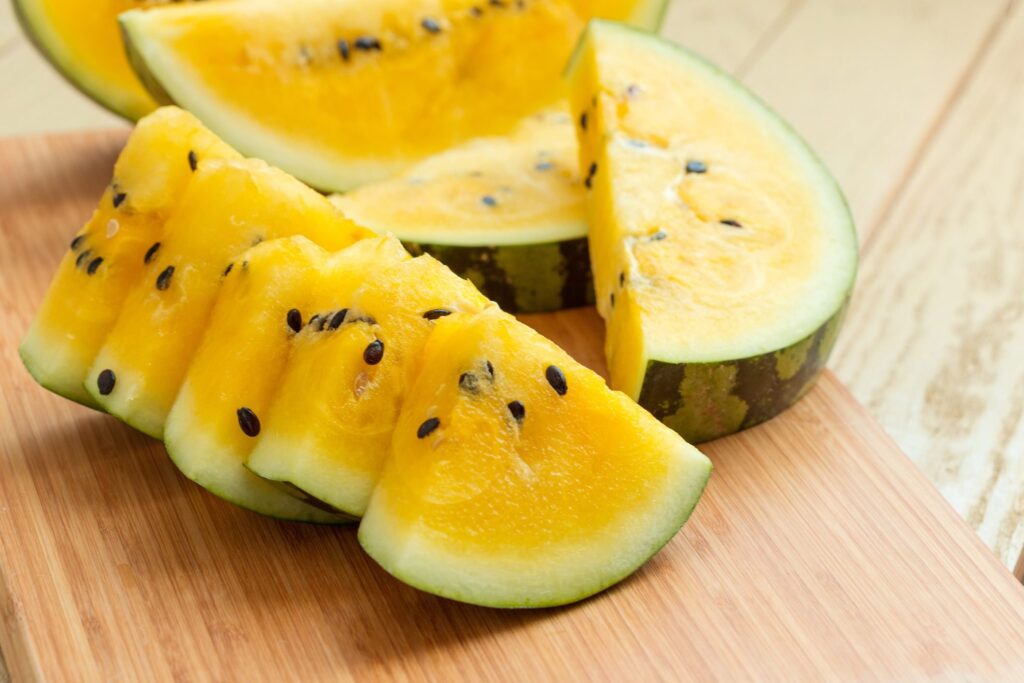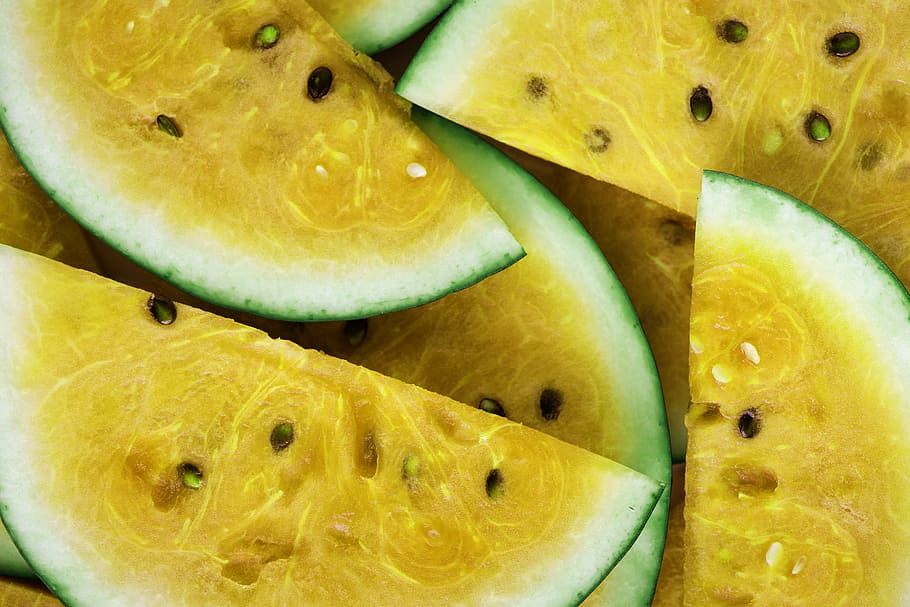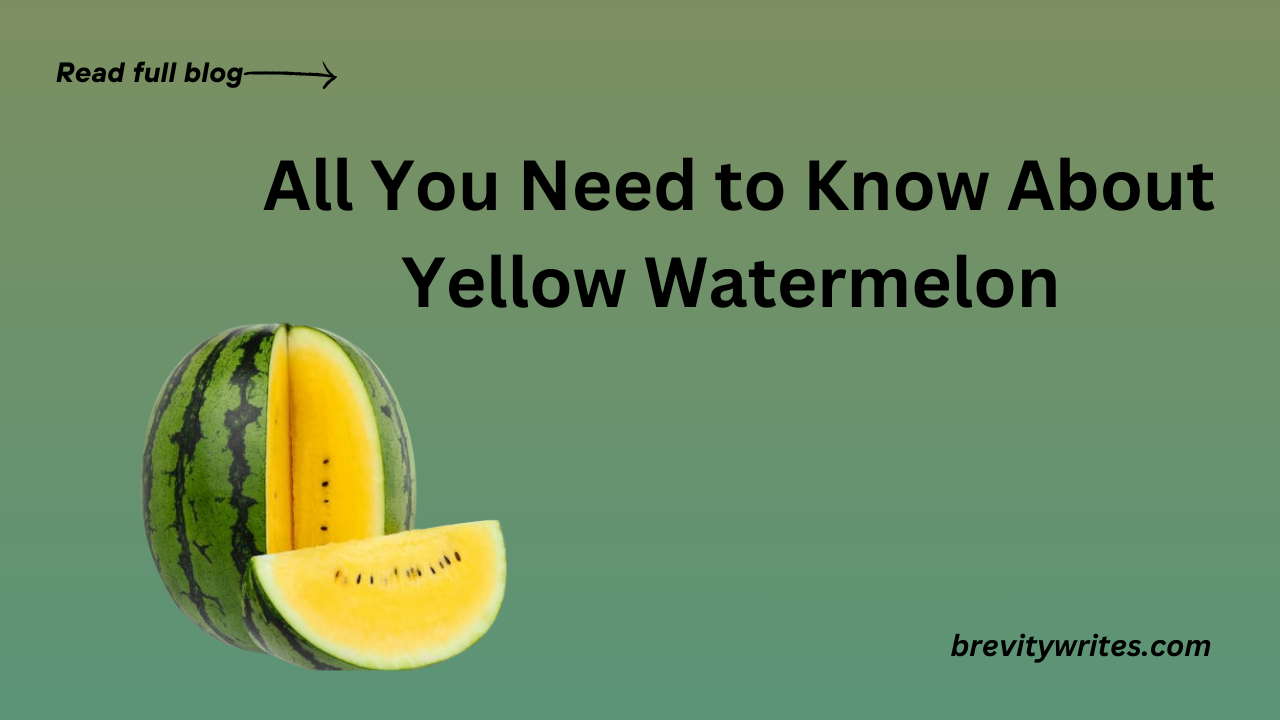Origin of Yellow Watermelon
The origin of the yellow melon can be traced to Africa from where one of the wild melon species – Citrullus lanatus is believed to have originated. Through centuries of cultivation and selective breeding, these watermelons have undergone various transformations that have led to the development of different varieties with different characteristics. Yellow-fleshed watermelon is a delightful deviation from the more common, red-fleshed varieties which is the result of specific genetic mutations that affect the production of pigments such as lycopene.
This mutation causes the fruit’s flesh to acquire a sunny yellow color from then yellow watermelon has become increasingly popular in recent years with its roots in traditional agriculture and biodiversity highlighting the fascinating journey of this sweet and vibrant fruit.
How Rare is the Fruit?
When compared to its common red counterpart the yellow watermelon is rare. Although red watermelons are the most popular variety yellow watermelons are prized for their distinctive flavor and look. Rarely is a specific genetic mutation linked to the yellow color of meat. These variants are purposefully cultivated by breeders, but their rarity adds to the awareness of their rarity. A wonderful and sought-after alternative for those wishing to discover the varied world of watermelon kinds, These watermelons are becoming more and more popular despite their rarity. This has led to greater cultivation and availability of this typical fruit in some locations.

How does it taste?
Yellow watermelon offers a delightful and subtly different taste compared to its red-fleshed counterpart. Its flavor profile is often described as sweeter and milder, with a hint of honey-like sweetness and a refreshing, tropical undertone. The absence of the typical tanginess associated with red watermelon allows the natural sweetness to shine through, providing a unique and enjoyable eating experience.
The texture remains crisp and juicy, making it a refreshing choice on a hot day. Yellow watermelon’s distinct taste adds a touch of novelty to this beloved summer fruit, making it a sought-after option for those looking to explore the diverse and delicious world of watermelons. The best part of these watermelons is you can enjoy them with your drinks.
Breaking down the Health Benefits and Nutritional Values
Breaking down the benefits and nutritional values of yellow watermelon provides insight into the healthful aspects of this vibrant fruit. Like its red counterpart, yellow watermelon is high in water content and low in calories. Vitamin C, which boosts immunity, and vitamin A, vital for healthy skin and eyes, are among the many vitamins it contains in plenty. Antioxidants like lycopene and beta-carotene recognized for their possible heart-protective and anti-inflammatory qualities are also present in yellow watermelon.
The fruit also provides a good source of citrulline and amino acids that are associated with improved blood flow and cardiovascular health. The bright yellow hue indicates the presence of certain phytonutrients which contributes to the fruit’s overall nutritional value. Incorporating yellow watermelon into your diet not only adds a burst of flavor but also brings a range of health benefits that help make it a delicious and nutritious choice for maintaining a well-balanced lifestyle.
Growing and harvesting Yellow Watermelon.
Growing and harvesting yellow watermelon involves several steps to ensure optimal taste and quality. When growing yellow watermelon, choosing a sunny location with well-draining soil is essential. Plant seeds or seedlings after the last frost, making sure there is enough spacing between plants to allow for proper growth. Yellow watermelons need constant watering, especially during hot and dry periods, to promote healthy fruit development. Mulching around plants retains soil moisture and suppresses weeds.
As the fruit matures, the rind changes color, and the tendril near the stem turns brown, indicating ripeness. Harvest yellow watermelon when the underside turns from green to yellow and the fruit is dull. The classic thumping method can also be used – a ripe watermelon produces a deep, hollow sound. After harvesting, store yellow watermelons in a cool, dark place. Following these guidelines will ensure a successful harvest of sweet and juicy yellow watermelons, ready to be enjoyed at the peak of freshness.

Types of Yellow Watermelon
There are several types of this fruit, each with its own unique characteristics. Some popular varieties include:
- Yellow Crimson: Recognizable by its bright yellow flesh, Which is known for its sweetness and juiciness.
- Yellow Baby Doll: This smaller-sized watermelon is perfect for personal consumption and is prized for its sweet and crisp taste.
- Tendergold: With a pale yellow to almost white flesh, Tendergold is celebrated for its exceptional sweetness and smooth texture.
- Yellow Doll: Similar to the traditional red watermelon, Yellow Doll has a vibrant yellow interior and is favored for its sweetness and refreshing taste.
- Sunshine: True to its name, Sunshine watermelon features a sunny yellow color and a flavor profile that balances sweetness with a hint of tanginess.
Comparing between Red vs Yellow Watermelon
The comparison between red watermelon and yellow watermelon extends beyond their visual differences, looking at taste, nutrition, and overall characteristics:
1. Color and Appearance:
• The most obvious difference is in the color of their flesh. Red watermelon has a vibrant red or pink color, while yellow watermelon has a sunny yellow to pale orange color.
2. Flavor Profile:
• Red watermelon is known for its classic, sweet, and sometimes slightly tangy taste. Yellow watermelon, on the other hand, is often described as sweet and mild, with a subtle honey-like sweetness and tropical undertone.
3. Nutritional Content:
• Both varieties share similar nutritional profiles, providing hydration, vitamins (such as vitamin C and A), and antioxidants. However, the specific pigments responsible for their colors—lycopene in red watermelon and beta-carotene in yellow watermelon—may provide slightly different health benefits.
4. Popularity and Availability:
• Red watermelon is the most common and widely available variety. Yellow watermelon, despite its growing popularity, is still considered a bit rare and may not be easily found in all markets.
5. Cultivation and Growth:
• Both types of watermelon grow in similar conditions, requiring warm temperatures, well-drained soil, and adequate sunlight. Cultivation techniques for red and yellow watermelons are largely interchangeable.
6. Market Awareness:
• Red watermelon is a traditional favorite and is often associated with summer picnics and barbecues. Yellow watermelon, being less common, can be thought of as a unique and new alternative, appealing to those looking for something a little different.








